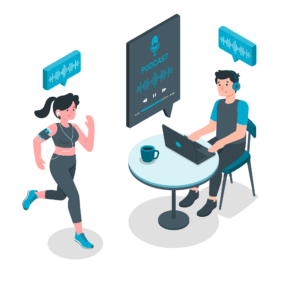How podcast can be used as a learning method ?
The health crisis has profoundly changed the way we operate, especially in the field of work and more particularly in corporate learning. Companies have had to adapt and find alternatives to continue developing their employees efficiently. As a consequence, new learning formats have emerged, including the podcast, which has become a real trend!
1) The rise of podcast
For several years now, we have been observing that audio is taking up more and more space in our daily lives, whether it is via streaming services, connected speakers, voice assistants, voice notes for exchanging with loved ones… We are witnessing a real boom in orality. This trend is driving us towards a new format: podcast. With 1,500,000 active podcasts worldwide, we no longer need to define it.
Podcast has now become established in the world of corporate learning. It is a shorter format than “traditional” e-learning, lasting between 15 and 45 minutes. Learners can listen to it in autonomy and often in a mobile context. The goal? Delivering educational content in a synthetic way, in a format that is more engaging for learners. Podcast is increasingly used as a learning method because of its many advantages.

2) The advantages of using podcasts in your learning paths
- Efficient learning: unlike face-to-face learning, podcasts do not require you to concentrate on a slideshow and suffer from possible background noise, you just need to concentrate on the audio you are listening to. This format allows you to build your own mental images from what you hear. Indeed, we know that the human brain is not able to concentrate on several things at the same time, otherwise it tires quickly and is much less efficient. Also, in this logic of efficiency, podcast can be delivered in a micro-learning format of about ten minutes.
- Mobility: One of the most obvious advantages of educational podcast is its mobility. Because of its format, it can be listened to anywhere and at any time! On the train, in the metro… all you need is a smartphone to listen to a podcast.
- Long-term knowledge retention: during a traditional course, a learner retains an average of 10% of the information. With podcast, it is possible to combine different learning methods to help the learner retain the knowledge in the long term: for example, you can use a podcast as a complement to a face-to-face training, in a shorter format concentrating on the key concepts of the course. Besides, the advantage of this format is that it gives the learner the possibility of downloading, listening to and re-listening to the content to better appropriate it and thus enhance learning and retention. In addition, podcast can be divided into several episodes (or even several seasons), which makes it possible to spread out production and listening over a longer period.
- Applicable to all fields: podcast can be used in absolutely all fields, and it also allows you to vary the types of learning materials available in your learning paths.
- Inclusive: podcast is a very good alternative for people with visual impairments or learning disabilities such as dyslexia, dyspraxia, etc. It is an easier medium than text.
- Simple: podcast is not that difficult to create. It is an inexpensive format. A smartphone and lapel microphones are all you need to record a podcast. Of course, for a better-quality podcast, you can invest in a recording booth and better quality equipment.

3. How to use podcast in learning?
Podcast is a format that can be used in a flipped classroom approach, during a learning path alternating face-to-face and distance learning. All that is needed is to provide an educational podcast beforehand, then use the face-to-face time with an instructor for an oral presentation, exercises or practice. This also allows the instructor to assess the learning: what did the learner understand from the podcast? In this way, the instructor and the group can exchange feedback.
Besides, educational podcast fits in with self-learning! When a learner is in the process where they seek to learn by themselves, they will turn to innovative, short and engaging learning formats. Podcast meets these criteria perfectly. With podcast, you can vary the types of learning materials and encourage self-learning!
In order to integrate a podcast into a learning path, it is necessary to ensure that certain key steps are taken in its development. Finding a name for the podcast, a jingle and a thumbnail is essential. You also need to have the right equipment to record a podcast. As for the content itself, it is necessary to think about a coherent strategy (what topic to cover? Which guest? How many episodes?). Of course, it is necessary to define a frequency of publication of the podcasts to anticipate each recording. Not forgetting the audio editing that needs to be done once the recording is complete. All that remains is to share it with the learners.
Conclusion
As you will have understood, podcast is a powerful learning method that can be used to adapt your learning design and vary the formats to improve learner engagement and knowledge retention. Today, an instructional designer must ask themselves what the best formats are to match their learners’ needs. Podcast is not the only trendy format that can be used in a learning path. Other formats such as educational videos or serious games are also very effective in learning! So, you need to find the right media for your learners, always with the same objective in mind: an efficient and engaging learning experience.
Latest news
Our latest articles about the topics: learning, science and Domoscio's news.